The latest in an ongoing series of themed collections of creative projects assembled by Prosthetic Knowledge. This edition continues an exploration of computational sculpture, objects that are shaped by computational processes, beginning with this article on early examples in the field.

Pussykrew, from the series "Unidentified Fabulous Objects."
For anyone with any interest in technology over the past four or five years, the emergence of 3D printing has been unavoidable yet incredibly inspiring, a method of fabrication that has been applied to everything from movie hero costumes to prefab houses.
The term "3D Printing," though, is itself potentially questionable. On appearance the technology resembles plotting machines more than printers (in the traditional sense of the word). Originally, the method was called "additive manufacturing" and defined as "the process of joining materials to make objects from 3D model data, usually layer upon layer, as opposed to subtractive manufacturing methodologies." This means that objects are formed from applying directed material from start to finish as opposed to using an already existing material form and creating a shape by removing from it. The first method of additive manufacturing was invented in 1984 (patented in 1986) by Charles Hull and called "Stereolithography," using ultraviolet light onto liquid photocurable resin (here is a retrotastic short video demonstration). Charles also invented the standard 3D Printing CAD file format STL. Other methods from the 80s include "Fused Deposition Modeling" by Scott Crump, which constructs forms using a controlled jet of filament (the method we are all most familiar with today) and "Selective Laser Sintering" which is similar to Stereolithography in practice but can produce forms in many other materials. Onwards into the 90s, more methods were introduced and businesses specializing in this manufacturing technology emerged. In 1993, MIT claimed a patent for "3 Dimensional Printing techniques" which were subsequently licensed to other companies, and the term has stuck since. Commercial 3D Printing machinery was initially bulky and slow, yet steadily has become faster. It was in 2005, though, that a hobbyist personal market emerged starting with the RepRap project, an open sourced model employing the fused filament model we are familiar with today, and ignited the awareness (and predictable hype) of the technology, able to fit on the future desktop. That isn't to say there are no further innovations in the commercial field—Mcor Technologies have put together a colour 3D printer that use layers of printed and cut paper to create 3D forms (although as you can see in this video, whilst the layering principle is present, the end object requires removal of unnecessary paper material). It does, though, resemble a technique closer to the original definition of printing.
This is an obviously promising area for artistic exploration, yet in many cases, the most widely promoted works in the medium are produced with the sponsorship of printing companies, existing only to demonstrate the technical potential of new tools. These works date quickly as the technology evolves, with new, more detailed and larger outputs, and a wider range of material filaments.
There have been smaller, independent, exhibitions of more compelling 3D printed works: Auru of the Synthetic by Matt Chalker who reproduced miniature examples of familiar contemporary art, and Open Shape, a collection of narrative pieces developed by several artists to be made and sold by the 3D printing company Shapeways.
For this submission, though, I want to focus in particular on artists who apply computational processes to objects, thinking through the translation of data into form via the 3D printing apparatus. These artists avoid the usual algorithmic clichés by exploring and thinking critically about 3D printing as a technical and cultural process.
Marius Watz

Form Studies (Makerbot), (2011)
A Norwegian artist based in New York, Marius Watz' practice is focused on generative coding and abstract computational aesthetics. He has described his process as "parametric modeling," defined as:
The modeling of a form as a system of generative rules, controlled by parameters that describe distinct qualities of that form.
The objects are almost like side effects or artefacts of these processes. Watz was one of the first artists on my radar who was exploring the path of 3D printing and digital fabrication, and is considered an important practitioner in this emerging field.

Probability Lattice (2012).

Modular Lattice (2012).
LIA

Austrian artist who has been creating digital art since 1995 explored the process of 3D printing itself for the project 'Filament Sculptures', a collection of experiments concerned with the behaviour and aesthetics of the filament material itself:
From the project's documentation tumblr:
I am really (!) not interested in creating 3D models in a 3D programme and then simply have them printed out. I rather wanted to know what can be achieved with the actual properties of filament and the movements of the printhead.
So i wrote some short processing application to directly output gCode: This is very basic, because you just define the location of the printhead, the speed of the movement and the amount of filament that should be extruded.
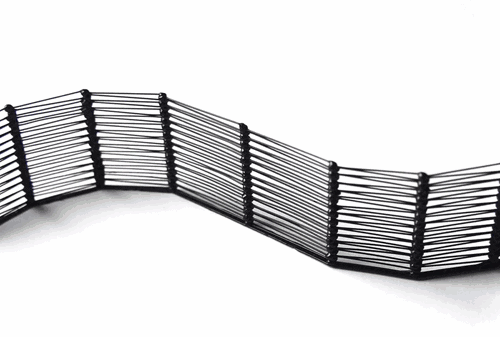
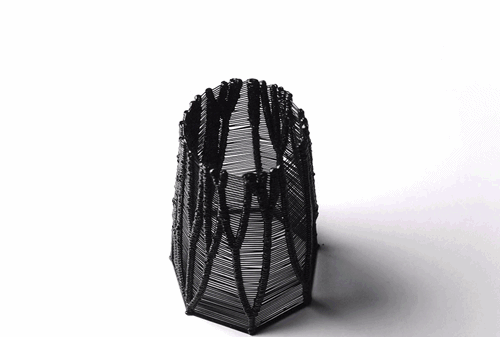
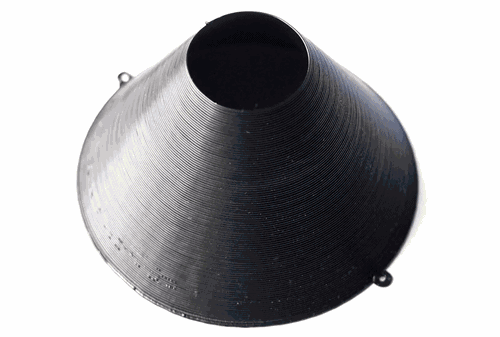
LIA's website; project documentation Tumblr; PK Link.
Matthew Plummer Fernandez

Venus of Google (2013).
London based British/Colombian artist with a focus on technology and the consequences of algorithms, often using the Processing language to code generative form, such as his Disarming Corruptor, a Mac app to encrypt-by-corrupt 3d object files to alter the virtual object form beyond recognition.


Digital Natives
For Digital Natives, Matthew took 3D scans of familiar mundane objects, processed the models and printed the results:
Everyday items such as detergent bottles and a watering can are 3D scanned using a digital camera and subjected to algorithms that distort, abstract and taint them into new primordial vessel forms. In some cases only close inspection reveals traces inherited from their physical predecessors.
Vessels are arguably the lowest common denominator for man-made objects across all cultures, these objects however have no storage function other than to embody the stored digital data that describes them.
For Venus of Google, a female-like form was generated from a single image of a woman which custom code utilized and generated a shape around a simple virtual block, and subsequently printed, a virtually generated form made physical:
The Venus of Google was 'found' via a Google search-by-image, googling a photograph taken of an object I had been handed over in a game of exquisite corpse. The Google search returned visually similar results, one of these being an image of a woman modelling a body-wrap garment. I then used a similar algorithmic image-comparison technique to drive the automated design of a 3D printable object. The 'Hill-Climbing' algorithm starts with a plain box shape and tries thousands of random transformations and comparisons between the shape and the image, eventually mutating towards a form resembling the found image in both shape and colour.
I'm interested in this early era of artificial intelligence, computer vision and algorithmic artefacts, exemplifying the paradox of technology being both advanced and primitive at the same time. This piece investigates the potential use of algorithms to create virtually infinite cultural artefacts.
Here is a video Matthew put together demonstrating the process:
Matthew's website: http://www.plummerfernandez.com/
Matthew's #algopop tumblr: http://algopop.tumblr.com/
SolarSinter Project
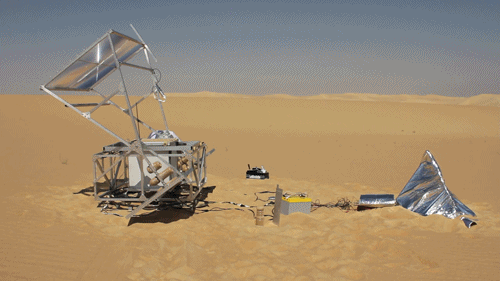

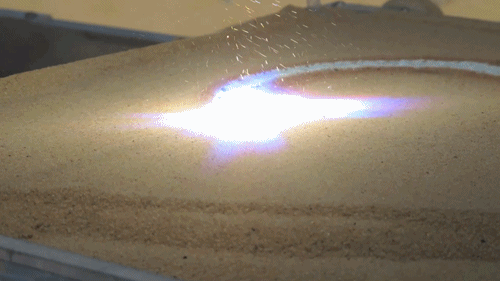

This is probably the most creative and poetic 3D printing method that has been put together: a project from 2011 by Markus Keyser utilizes magnified solar power and sand as material to create glass objects. Here is a video of the computer-controlled machine being used in the Morrocan Desert.
And from the project description:
In the deserts of the world two elements dominate—sun and sand. The former offers a vast energy source of huge potential, the latter an almost unlimited supply of silica in the form of quartz. The experience of working in the desert with the Sun-Cutter led me directly to the idea of a new machine that could bring together these two elements. Silicia sand when heated to melting point and allowed to cool solidifies as glass. This process of converting a powdery substance via a heating process into a solid form is known as sintering and has in recent years become a central process in design prototyping known as 3D printing or SLS (selective laser sintering). These 3D printers use laser technology to create very precise 3D objects from a variety of powdered plastics, resins and metals—the objects being the exact physical counterparts of the computer-drawn 3D designs inputted by the designer. By using the sun's rays instead of a laser and sand instead of resins, I had the basis of an entirely new solar-powered machine and production process for making glass objects that taps into the abundant supplies of sun and sand to be found in the deserts of the world.
More here.
Pussykrew



Polish couple Andrzej Wojtas and Ewelina Aleksandrowicz have worked in various digital forms such as motion and animation. Inspired by net art aesthetics, the duo invested in a 3D printer to bring a fluid, gender-bending style into physical reality. Initial models were shown to be constructed with a 3D printer with a live video stream and documented on their Unidentified Fabulous Objects Tumblr. Their efforts were recently exhibited at the London 3D Printshow, and won the art category.
Ashley Zelinskie
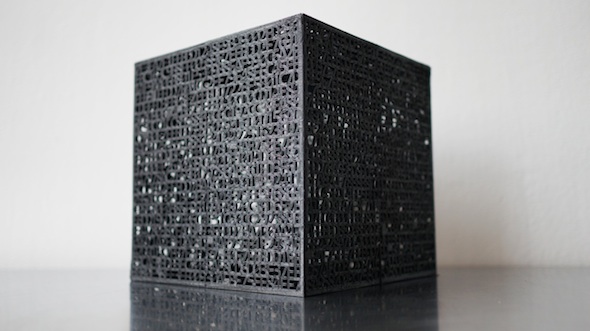
Reverse Abstraction

One and One Chair
Brooklyn-based artist, now in residence at NEW INC, whose works focus on the interplay between language and computer technology. In her Reverse Abstractions series, 3D volumes such as cubes and chairs are formed from a rigid skin of densely packed alphanumeric characters. This is not a cosmetic touch—the characters are the hexadecimal values of the 3D object files they represent; thus, these are objects which both people and computers can understand:
… humans and computers perceive the world through different languages, and what is concrete for one is abstract for the other. The objects and shapes so familiar in human art can be neither perceived nor conceived by computers in their original form. Likewise, the codes that are so familiar to a computer are merely scattered symbols to human sensibility. The Reverse Abstraction series attempts to bridge the gap by constructing traditional objects in dual forms: as the classical object and as the hexadecimal and binary codes that represent them. Thus, abstraction becomes material, the meanings for humans and computers are united, and the duality is resolved.
Ashley's website: http://www.ashleyzelinskie.com. A large-scale laser-cut cube from the Reverse Abstractions series was recently acquired by the US State Department for installation in the US Consulate in Jeddah, now under construction, no doubt because of its visual resonance with the Kaaba.
Morehshin Allahyari



Iranian artist now based in the US created the "Dark Matter" series of printed artifacts designed with 3D software that combine surreal and humorous object combinations. These objects individually are either banned or frowned upon in Iran. Weird and nonsensical yet politically motivated, the project highlights the potential for computational sculpture to create and transform cultural archives. To some, owning a 3D printer could be considered a political act:
"Dark Matter" is a series of combined, sculptural objects modeled in Maya and 3D printed to form humorous juxtapositions.; The objects chosen for the first series are the objects/things that are forbidden or un-welcome in Iran by the government. The objects that in many other countries people use or own freely but under Iranian government laws (for several reasons) are forbidden or discouraged to use. Owning some of these objects/things (dog, dildo, gun, neck tie, satellite dish, etc.) means going to jail, or getting a fine, or constantly being under the risk of getting arrested or bothered by the moral police. By printing and bringing the virtual 3D into physical existence, I want tosimultaneously resist and bring awareness about the power that constantly threatens,discourages, and actively works against the ownership of these items in Iran. No matterhow functional, through 3D printing, I am able to re-create and archive a collection offorbidden objects. In a way, the sculptural objects serve as a documentation of lives (my own life included) lived under oppressions and dictatorship. This is the documentation of a history full of red lines drawn in the most private aspect of one's life.
Project webpage; step-by-step guide to the method on Instructables.
Jonathan Keep

Icebergs
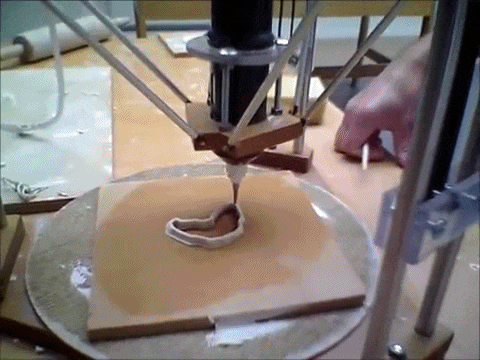
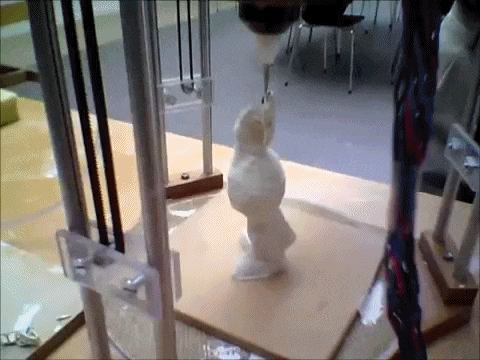

Seeds

Random Growth

Sound Surface
British artist Jonathan Keep has put together a method of 3D printing objects using a more traditional art material—clay. Working in sculpture for more than 20 years, the 3D printer (and computer) has extended his range of creative development. Various projects has seen vases made of sound data and random outputs based on natural computational processes, subsequently fired and glazed:
I have long used computer software to develop new ceramic forms. With an interest in the hidden numerical code that underpins all nature I have developed a working process whereby the shapes of these pots are written in computer code. This digital information is passed to a studio based DIY 3D printer that I have adapted to print in clay. Layer by layer the pots are printed out – a sort of mechanical pottery coil building. After printing, the ceramic is fired and glaze in the normal way.
From the elemental forces of earth, fire and water pottery has traditionally drawn on nature for inspiration. In using computer code to create this work I aim to add a further layer to include the elemental, naturalmathematical patterns and structures that underlie all form. The appreciation of this work illustrates just how much we are connected at a very deep level to the natural world.
Jonathan's portfolio of digital pots.
See also: Two projects that convert music into 3D meshes for 3D printing, Sonic Prints and Microsonic Landscapes.
Gokinjo Monozukuri
And finally… Japanese collaborative artists Gokinjo Monozukuri (made up of Nukeme, Kanno and yang02) together work on projects exploring creative potential with 3D software and photogrammetry (the method of constructing 3D objects with a collection of photographs taken at various angles.) One such project is the fashion focused Computer Copy where a garment is worn and captured, reduced to a smaller polygon count, and reconstructed with digital fabric prints. Another project, Captured Desire, aimed to reconstruct portraits of famous personalities using various photos on Google Image:
There is a web service which makes 3D models using the pictures taken from various angles. The aim of making "Captured Desire" is printing full colored 3D model by collecting similar uploaded images on the internet instead of taking pictures by ourselves. The more attention the subjects gather, the more images are uploaded on the internet with the result of higher resolution of the 3D models.
These days, a lot of 3D cameras and softwares are developed, and we expect that everything in the world will be 3D modeled with high resolution in the near future. The method of our work is kind of cloud-sourcing and suggests a new way of 3D modeling at the moment in which the 3D system is not fully grown. Therefore, our printed 3D models are distorted and don't have the back side. But we can say that this is a sampling of the present moment of technology which progresses rapidly. Our models will also express the desires of the people living in the present day by showing the amount of popular images and the number of access counts.

